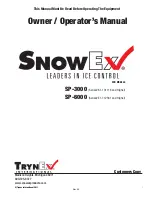
© Trynex International 2011
10
General Wiring Instructions
Model # SP-3000/SP-6000
step 1
: Take harness assembly and route from the rear of the vehicle to the front. Route harness along frame and attach to frame holes and
frame supports. It is not recommended to attach to fuel or brake lines for obvious reasons. Do not route close to exhaust system or engine, even
though Snowex uses high temperature wiring, it still could melt under extreme heat and short the spreader electrical system, as well as the
vehicle electrical system.
step 2
: Mount rear plug on bumper using supplied bolts, locate towards the center of the bumper to reduce the amount of debris the tires will
throw to the rear. Important: Apply a small amount of dielectric grease to the plug. Also try to mount so plug faces upward to help keep plugs
tightly sealed.
Step 3: Secure harness from the rear to the front using heavy duty ty-wraps or frame clips along the frame and lighter duty ty-wraps everywhere
else.
step 4:
Layout harness portion that connects to the battery along the re wall and fender well. Do not connect power leads to battery yet. Drill
a 3/4” hole in the fire wall, or use existing access hole, for the control portion of the harness and route connector and harness through hole.
Be sure to check the area on the other side of the fire wall to make sure you are not going to dri ll into the vehicle harness or a control module.
Generally you can drill on either side of the steering wheel for a good location.
step 5:
Connect harness to the back of the controller and mount to a suitable location. NOTE: You may want to contact customer before mounting
controller, some prefer not to have holes drilled into the dashboard. Ty-wrap loose controller harness and move to the engine compartment. Do
not mount close to any heater vents.
step 6
: Connect power leads to the battery: Red + Positive, Black – Negative, always connect to the primary battery if using a dual battery
system, secure loose loom to any other large or medium vehicle harness with medium duty ty-wraps; this will secure wiring harness.
step 7:
Push the ON/OFF button on the controller to check for power, when that has been conrmed turn power OFF. The electrical portion of the
installation is complete.
note:
If adding an inline fuse use a 60 amp slow blow (time delay) or a 60 amp relay.
Rev. 02

























